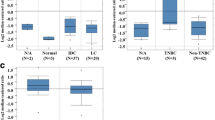Abstract
Background
Some of the induced pluripotent stem cell (iPS cell)-inducing factors have been reported to be expressed in breast cancer. The aim of the present study was to examine the relationship between the expression of iPS cell-inducing factors and the prognosis of breast cancer patients.
Methods
In 100 breast cancer patients, the expression of c-MYC, KLF4, NANOG, OCT4, and SOX2 was determined by immunohistochemistry using a tissue microarray analysis.
Results
Patients with strong expression of NANOG had significantly lower disease-free survival (DFS) and overall survival rates than those with weak expression of NANOG (P = 0.004 and 0.033, respectively). In contrast, patients with strong expression of KLF4 had better DFS (P = 0.014).
Conclusions
Strong expression of NANOG is an indicator of a poor prognosis for breast cancer patients, whereas KLF4 is a favorable prognostic indicator. Our results suggest that NANOG stimulates the growth and metastasis of breast cancer cells, whereas KLF4 inhibits these processes.


Similar content being viewed by others
References
Takahashi K, Yamanaka S. Induction of pluripotent stem cells from mouse embryonic and adult fibroblast cultures by defined factors. Cell. 2006;126:663–76.
Yu J, Vodyanik MA, Smuga OK, Antosiewicz BJ, Frane JL, Tian S, et al. Induced pluripotent stem cell lines derived from human somatic cells. Science. 2007;318:1917–20.
Monsef N, Soller M, Isaksson M, Abrahamsson PA, Panagopoulos I. The expression of pluripotency marker Oct3/4 in prostate cancer and benign prostate hyperplasia. Prostate. 2009;69:909–16.
Masui S, Nakatake Y, Toyooka Y, Shimosato D, Yagi R, et al. Pluripotency governed by Sox2 via regulation of Oct3/4 expression in mouse embryonic stem cells. Nat Cell Biol. 2008;9:625–35.
Rodda DJ, Chew JL, Lim LH, Loh YH, Wang B, et al. Transcriptional regulation of nanog by OCT4 and SOX2. J Biol Chem. 2008;280:24731–7.
Soucek L, Evan GI. The ups and downs of Myc biology. Curr Opin Genet. 2010;20:91–5.
Evans PM, Liu C. Roles of Krupel-like factor 4 in normal homeostasis, cancer and stem cells. Acta Biochim Biophys Sin. 2008;7:554–64.
Ezeh UI, Turek PJ, Reijo RA, Clark AT. Human embryonic stem cell genes OCT4, NANOG, STELLAR, and GDF3 are expressed in both seminoma and breast carcinoma. Cancer. 2005;104:2255–65.
Deming SL, Nass SJ, Dickson RB, Trock BJ. C-myc amplification in breast cancer: a meta-analysis of its occurrence and prognostic relevance. Br J Cancer. 2000;83:1688–95.
Fukuoka J, Fujii T, Shih JH, Dracheva T, Meerzaman D, Player A, et al. Chromatin remodeling factors and BRM/BRG1 expression as prognostic indicators in non-small cell lung cancer. Clin Cancer Res. 2004;10:4314–24.
Yamanaka S. Pluripotency and nuclear reprogramming. Philos Trans R Soc Lond B Biol Sci. 2008;363:2079–87.
Jeter CR, Liu B, Liu X, Chen X, Liu C, et al. NANOG promotes cancer stem cell characteristics and prostate cancer resistance to androgen deprivation. Oncogene. 2011;30:3833–45.
Leis O, Eguiara A, Arribillaga EL, Alberdi MJ, Garcia SH, et al. Sox2 expression in breast tumours and activation in breast cancer stem cells. Oncogene. 2012;31:1354–65.
Naderi A, Weschendorff AE, Barbosa-Morais NL. A gene-expression signature to predict survival in breast cancer across independent data sets. Oncogene. 2007;26:1507–16.
Akaogi K, Nakajima Y, Ito I, Kawasaki S, Oie SH, Murayama A, et al. KLF4 suppresses estrogen-dependent breast cancer growth by inhibiting the transcriptional activity of ERalpha. Oncogene. 2009;28:2894–902.
Al-Haji M, Wicha MS, Benito-Hernandez A, Morrison SJ, Clarke MF. Prospective identification of tumorigenic breast cancer cells. Proc Natl Acad Sci U S A. 2003;100:3983–8.
Ponti D, Costa A, Zaffaroni N, Pratesi G, Petrangolini G, Coradini D, et al. Isolation and in vitro propagation of tumorigenic breast cancer cells with stem/progenitor cell properties. Cancer Res. 2005;65:5506–11.
Cai GL, Ying L, Bin BW, Yan JZ, Rui SZ, et al. Clinical implications of stem cell gene Oct-4 expression in breast cancer. Ann Surg. 2011;253:1165–71.
Acknowledgments
We are grateful to Dr. T. Hori for the valuable technical assistance. This study was supported by grants from the Ministry of Education, Culture, Sports, Science and Technology of Japan.
Conflict of interest
None.
Author information
Authors and Affiliations
Corresponding author
About this article
Cite this article
Nagata, T., Shimada, Y., Sekine, S. et al. Prognostic significance of NANOG and KLF4 for breast cancer. Breast Cancer 21, 96–101 (2014). https://doi.org/10.1007/s12282-012-0357-y
Received:
Accepted:
Published:
Issue Date:
DOI: https://doi.org/10.1007/s12282-012-0357-y




